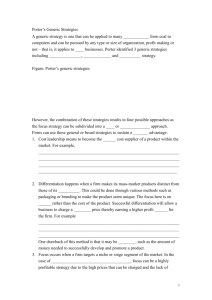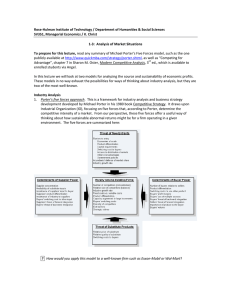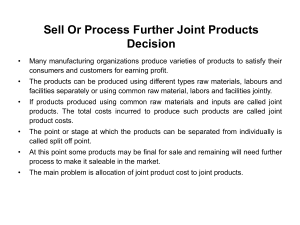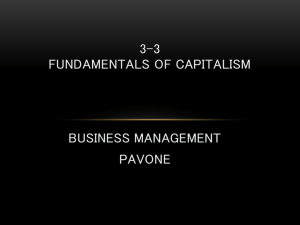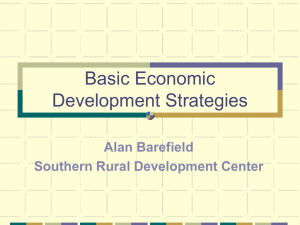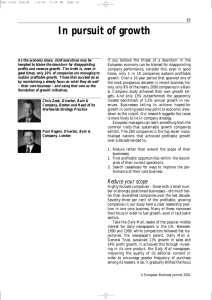Strategy: Chapter 6 Formulating Business Unit Strategy
advertisement
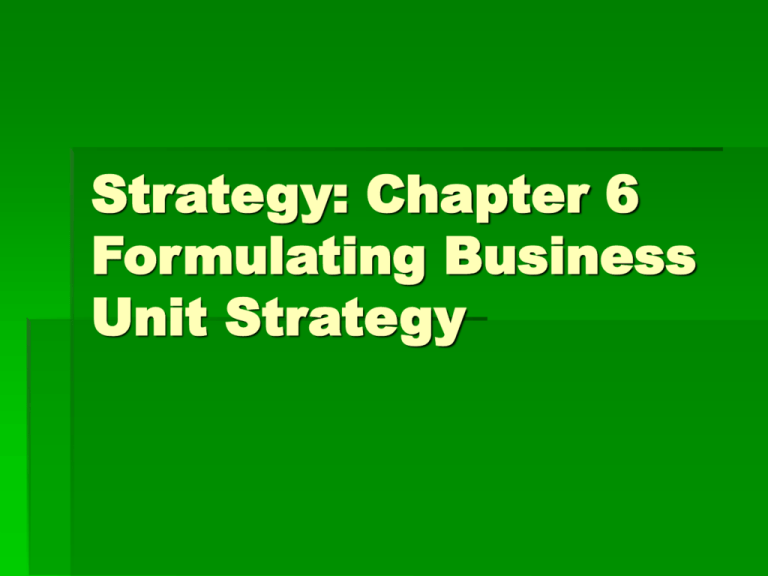
Strategy: Chapter 6 Formulating Business Unit Strategy Overview Porter’s generic business strategy Value Chain analysis Value Discipline Business Models Business unit strategy involves creating a profitable competitive position for a business within a specific industry or market segment. Strategic Logic at the Business Unit Level The attractiveness of different strategic options depends on the competitive situation. Michael Porter articulated a “strategic logic” that guides much of our strategic thinking at the business level. Firm success is explained by two factors: attractiveness of the industry and it relative position. How much does industry matter? Industry Industry Segment Corporate Parent 32% 4% 19% Relative Position What is the nature of the competitive position? Either lower delivered cost or differentiation. Also depends on scope. Importance of Market Share Profitability vs. Market Share A&P and Intel are high market share failures Managing for volume growth or value growth? Formulating A Competitive Advantage Key Challenges Analyzing the competitive environment Anticipating key competitors actions Generating strategic options Choosing among alternatives Competitive Advantage (e.g., Southwest) Sustainability (VRIN) Value Chain Analysis Porter’s Generic Business Unit Strategies Differentiation or Low Cost Low Cost Broad Market vs. Cost Focus Broad Market Example: Wal-Mart Company chooses broad target market Economies of Scale, Experience effects in purchasing and manufacturing Cost Focus Example: Southwest Airlines Well defined market niche – short roots & secondary airports All activities focused on serving that niche Differentiation To provide something of value to the customer other than low price Use more than 1 source of differentiation higher quality raw materials, unique product design, more reliable manufacture, superior marketing and distribution Requires thorough understanding of what customers value Critique of Porter’s Generic Strategy Not always viable Low cost not effective when low cost is industry norm Not Mutually Exclusive Total Quality Management Value Disciplines (Treacy & Wiersema, 1993) Product leadership Produce a continuous stream of state-of-theart products and services Based on four principles 1) encouragement of innovation 2) risk-oriented management style 3) talented product design people 4) educate and lead the market Here is an example: Value Disciplines Operational Excellence Strategic approach aimed at better production and delivery mechanisms Wal-Mart, American Airlines, Fed-Ex Value Disciplines Customer Intimacy Concentrates on building customer loyalty Can be expensive, but the long-term benefits of a loyal clientele can pay off Employee Competencies Product leadership – info. sharing, creativity, group-problem solving, visionary Operational Excellence – process control, continuous improvement, teamwork Customer Intimacy – relationship building, listening, initiative, quality-focused What is a business model? Business Model A firm’s business model is its plan or diagram for how it competes, uses its resources, structures its relationships, interfaces with customers, and creates value to sustain itself on the basis of the profits it generates. The term “business model” is used to include all the activities that define how a firm competes in the marketplace. Dell as an example Designing a Profitable Business Model Designing a profitable business model is a critical part of formulating a business unit strategy How can we earn sustainable profits? Where will we be able to make profits? How should the business model be designed so that we will be profitable? 1. Customer Development/Solutions • • Find ways to improve customers’ economics and processes Ex: Priceline.com 2. Product Pyramid • • Variety of products, most profitable on top, bottom serves as a barrier to entry Ex: Marriott 3. Multicomponent System • • Focus on components that generate substantially higher profits Ex: Room rentals vs. bar operations for hotels, Casinos 4. Switchboard • • • Connect multiple sellers to multiple buyers Low costs for both, in exchange for a fee Ex: banks 5. Time • • • First-mover advantage Requires constant innovation Ex: Apple 6. Blockbuster • • Profitability driven by a few great products Ex: Movie studios or pharmaceutical companies 7. Profit Multiplier • • • Reaps gains repeatedly from same products, services…etc. Works well with strong consumer brands Ex: Michael Jordan, Disney 8. Entrepreneurial • • Take advantage of other companies’ lack of closeness to customers Works for small companies 9. Specialization • • Growth through sequenced specialization Ex: Consulting companies 10. Installed Base • • Customers buy consumables or follow-on products Ex: software & upgrades 11. De Facto Standard • • When the Installed Base has become the industry standard that governs competitive behavior Ex: Oracle, Microsoft


